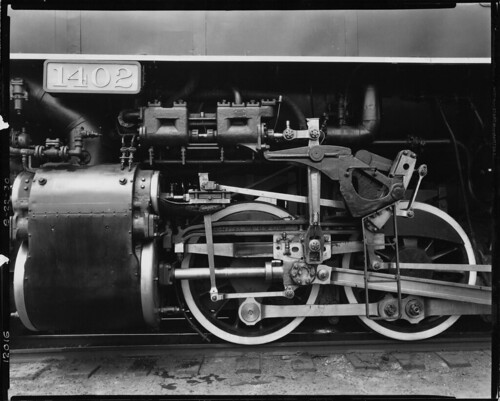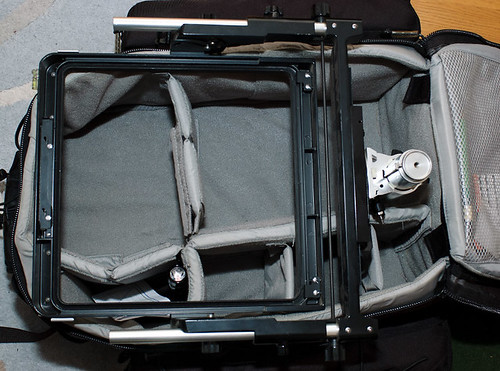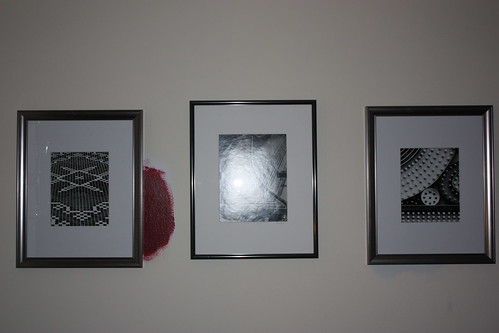Gemma on PQ
Image by GregRob
Gemma relaxes with some stuffed toys while I try out my first sheet of Impossible PQ 8x10.
I flipped the image in Photoshop. There are Newton's rings here and there in the 600 dpi scan. The rings aren't as visible in the 300dpi upload.
I included a Kodak gray scale target in the photo lower right, and in the scan along the left edge. The original is now in a plastic box along with a lot of Silica. I didn't peel it, it turned out too nice for a process which I know will degrade the image. I am crossing my fingers on the silica.
The original in hand looks excellent, I hope it does not change much while drying. The quality is quite good, the development appears even, and isn't splotchy at all.
Having Gemma low in the frame was an intentional part of the composition as I wanted the Deardorff and a bit of myself to show up in the mirror at the top.
Photo info/Strobist info: Photographed on Impossible Project PQ 8x10 rated 640 ASA, in a Deardorff V8, using a Nikor 300mm f9 lens. Exposure 1/60s f/11. Lighting: Jinbei QQ250 at 3/8 power to camera right, shooting through a white umbrella, triggered using a Cactus V4 trigger. Metered using a Minolta Spotmeter F, off of a Lastolite Ezybalance Gray card.
Builder's Photo of 2-8-0 Locomotive No 1402 "James Archbald," built in 1930 by the Delaware & Hudson Railroad.
Image by Podsville
At least, I think that's what it is.
A few weeks ago I spotted an 8X10 black and white framed print in an antique mall in Allen, Michigan. The unusual subject and the extraordinary quality of the image caught my eye. The print was badly wrinkled but otherwise in good condition. I suspected that the wrinkles were the result of a botched mount job, in which case any effort at salvaging the print would have been impossible, but I couldn't tell for sure while it was behind glass in the frame. Since the price was only I decided to take a chance.
Upon removing the print from the frame I was happy to find that it was not stuck to either the glass or the backing board., and that it was an actual silver-halide photo print and not a halftone reproduction.
I wanted to remove the wrinkles if possible, both because they detracted greatly from the appearance of the print and also to make it possible to get a good scan. I thought that the print would soften and become limp if it were soaked in water, but I know from personal experience that photo paper made before the advent of resin coating will curl badly if simply air-dried. A "blotter roll" would be ideal for the job, but the chance of finding such a thing these days is nil. Eventually I decided to use pant hangers at the top and bottom to keep the print stretched as it dried, and this proved to be very satisfactory, The wrinkles are gone, I got the scan which you see here, and the original is back in the frame and looking very fine indeed.
The characteristic shape of the unexposed areas on the long sides caused by the sheet-film holder and the film manufacturer's edge markings told me that this is a contact print of an 8X10 negative, which accounts for the remarkable sharpness and tonal qualtiy. The edge marking reads "EASTMAN-NITRATE-KODAK." The nitrate base which supported the emulsion on film made many decades ago was highly flammable, so it was eventually replace by cellulose acetate, which removed the fire hazard. If you've seen the phrase "Kodak Safety Film," that's what it refers to.
The number 12016 and the date 8-22-30 were written on the negative by hand.
My next step, of course, was to Google "locomotive 1402." I wouldn't have been surprised if this photo had been mass produced for sale at train shows, and I expected to find it showing up on lots of web pages. Instead I found only a few references to locomotives bearing the number 1402, and no reproductions of "my" photograph.
I believe this is a photo of the engine shown here. The same locomotive is mentioned here, where it is said to have been built at the Alco-Schenectady Works.
The D&H 1402 was built in 1930, which corresponds to the date on the photo, so my guess is that I have an original builder's photo, made at the works before the locomotive was put into service. Certainly the fact that it was shot with an 8X10 camera and the superb craft evident in every step from exposing the film to making the final print suggest a professional job.
One thing this photo lacks is a sense of scale, but according to one of the web pages cited above those drivers are a little over 63 inches in diameter. This was a huge machine!
I hope that all who chance to view this image will share my pleasure in this lovely artifact of railroading and photography as practiced nearly eighty years ago. If anyone can correct or confirm my identification, or has any other information to share about either the locomotive or the photograph, I'd be very grateful if you'd leave a comment.
Sunoka Winter Trees
Image by JeremyOK
8x10 framed,
Summerland, 2010
Pro trekker II backpack... Too small
Image by Jukka Vuokko
Test with 8x10 Toyo G back frame and my largest backpack.
No way to fit in :D
4x5 monorail view camera fits easily: www.flickr.com/photos/jvuokko/3477771200/
Have to look for some good solution. Perhaps a really big backpack mounted on a light frame would do it..
My Work, Framed!
Image by ninniane
July 17 - I went to Walgreens today and printed three of my pieces as 8x10's. I framed two of them and put them on the wall next to a photo that was a gift from my partner's father. I haven't found a place for the third photo yet. It's in a different frame, so I'm still working on where it ought to go.
No comments:
Post a Comment